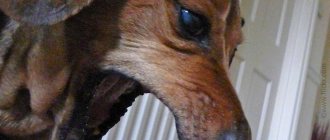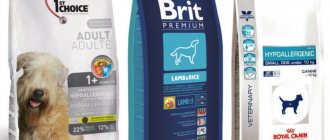Dental diseases in dogs are caused by the fact that it is quite difficult for them to maintain oral hygiene. One possible complication is flux. This is a very painful condition, so any owner wants to help their pet as quickly and effectively as possible. To provide assistance in the initial stages, you need to know the symptoms and methods of treating a dog with flux.
What is flux (periostitis)
Periostitis (flux) in a dog is a condition in which inflammation of the tissues surrounding the periosteum occurs. Usually the disease is benign and well tolerated, and gum healing occurs very quickly. But the disease can take the form of a severe infectious infection. This is much more serious and will require intensive care.
A common cause of acute gum inflammation is oral surgery, which a furry patient recently underwent. While the healing process is underway, the wound may become inflamed.
Plaque is the second cause of infection. In its structure, tartar resembles a porous sponge, and this is an ideal environment for the development of bacteria. As their number increases, inflammation and suppuration of the tissues begins. This is also facilitated by the fact that tartar moves the gum away from the tooth, thereby expanding the space in which pieces of food can be deposited. Mixing with saliva, they form a coating on which microorganisms develop.
Prevention of periostitis
To prevent re-infection, a number of preventive measures should be followed:
- systematically take the animal for examination to the veterinarian,
- do preventive treatment of the oral cavity at least once a year;
- periodically clean the dog’s teeth using gauze soaked in a soda-based solution;
- include industrial dry food in the nutrition plan.
In addition, it is necessary to supplement the diet with sugar bones, which will help the pet grind and clean its teeth.
Some owners believe that it is possible to limit the diet of their four-legged friends to soft canned food. This opinion is wrong. Such a neglectful attitude towards the physical condition of the pet leads to the formation of tartar, which provokes the development of gumboil and other inflammatory diseases of the oral cavity.
Video - Removing tartar in dogs
Oral diseases in dogs are more common than others. This is primarily due to the owner’s oversight, improper upbringing of the dog, and negligent attitude towards the needs of the pet.
Types of periostitis in dogs
The inflammatory process can occur in different ways.
It is classified according to the following criteria:
- localization or location;
- extent of distribution;
- stages of occurrence;
- reason for appearance.
Did you know? The first case of periostitis was diagnosed by paleontologists in the Late Cretaceous-Eocene crocodile Borealosuchus formidabilis. There are also documented cases of this disease being found on dinosaur bones.
Depending on its location, the flux in a dog can be localized on the upper or lower jaw. According to the degree of distribution, limited and diffuse fluxes are distinguished. The first is located at one or two adjacent teeth, and the second extends to the entire jaw. According to the stage of occurrence, the inflammatory process is divided into acute and chronic.
There is a classification for the reasons why flux appears in a pet:
- traumatic;
- lymphogenous;
- hematogenous;
- odontogenic.
The first is the result of injury. The second is a natural result of bacteria entering the lymph, the third is the result of contamination of the bloodstream with bacteria from the oral cavity or others. The fourth is the result of existing dental diseases.
Serous
The periosteum (periosteum) is the tissue that covers the outside of the jaw bones.
Injury in this area is possible as a result of:
- dog fight;
- accidents;
- careless play with a pet (bruise, fracture).
Important! A dog who has developed gumboil will avoid playing with toys that involve chewing or engaging in activities that require biting (such as carrying a stick or tug of war).
The injured area swells due to the influx of serous fluid to the injury site. Therefore, this form of flux is called serous.
It is accompanied by:
- swelling;
- sometimes pain.
With minor injuries, the swelling quickly subsides and the situation stabilizes. This form of periostitis is also called simple.
Diffuse
Sometimes fibrous fluid spreads over the surface of the jaw. This is preceded by a large area of bruise. If nothing is done, suppuration may begin. There is a danger that with prolonged inflammation, tissue will begin to break down.
Acute and purulent
Acute inflammation can occur in two forms. It happens:
- serous;
- purulent.
In the serous form, the edema consists of a clear liquid. It dissolves quickly. There is no infection. The purulent form is accompanied by suppuration. Flux is formed, and after a while the purulent contents may begin to leak out.
Did you know? Providing your pet with good oral hygiene can prolong its life by 2
-4
years.
The flux is accompanied by:
- heat;
- pain;
- loss of appetite and activity.
The pet eats little - and only soft food. If there is a wound surface, bacteria can get inside. This increases the likelihood of purulent inflammation. Pus can also be the result of inflammation of the tissues of the tooth itself.
Chronic
The division of inflammatory processes into acute and chronic implies that the former begin suddenly, and the latter last for a long time, then subsiding, then starting again. Chronic inflammation is accompanied by the proliferation of bone tissue and deformation of the jaw shape. It can be either a reversible or irreversible process.
Symptoms and signs
The owner of the animal may suspect the development of the disease when the dog wants to eat, but cannot do so. A hungry animal restlessly walks around the bowl, tries to chew food, but experiences severe pain and spits out the food. The same thing happens with water. At the same time, the dog’s entire jaw hurts.
The pet sleeps restlessly, whines, and constantly jumps up. When examining the jaw, loose teeth may be detected. There may be blood left in the bowl. The mouth smells bad, the animal is drooling, and there may be bleeding from the nose.
With the serous type of pathology, the jaw swells and the periosteum swells. In a dog, one part of the muzzle becomes larger than the other, but this is not a mandatory sign. In this case, the pet can behave as usual without experiencing pain.
With purulent inflammation of the periosteum, wounds on the gums are visible. The animal's body temperature rises, the oral cavity swells and becomes red, and profuse salivation is observed.
With diffuse flux, the dog feels heavy. The dog may lie and whine pitifully, constantly fiddling with its muzzle. The body temperature is very high, salivation is increased, and blood often flows from the mouth.
Why does flux develop in dogs?
Inflammation of the periosteum is caused by various reasons.
The most common:
- injury;
- infection.
Did you know? Most dogs do not stop eating even when they have severe periodontal disease. Therefore, lethargy and refusal to eat
-
This is often a sign of an infectious or viral infection, rather than dental disease.
An untreated infection can spread to other oral tissues in addition to the gums.
Therefore, antibiotics are necessarily prescribed for treatment. Home treatment can help relieve discomfort, but it will not cure flux infection in a dog.
What to do if you find flux in your dog's mouth
Oral disease occurs periodically in dogs of any breed. The appearance of flux is associated with failure to regularly care for the dog’s oral cavity.
Lack of proper care results in the formation of tartar, so gumboil in dogs is a common ailment. The disease is also called periostitis, a complex disease that is characterized by infection of the upper part of the tooth root.
The disease requires surgical treatment, so it is not recommended to delay a visit to the veterinarian.
First necessary actions
Before starting therapy, it is necessary to have a good understanding of the cause of the disease. Treatment of flux in dogs at home begins with proper care of the animal, since appropriate care will contribute to a rapid recovery. The active movement of the dog should be limited.
Of course, this does not mean that the pet must be completely restricted from movement, but physical activity and training must be excluded. In addition, it is necessary to guarantee the pupil rational feeding in order to prevent the occurrence of additional complications with the bones. Therefore, add healthy vitamins and minerals (vitamins D, Ca, P) to your daily menu.
My dog has flux, what should I do? The first thing you need to do is immediately consult a doctor. The veterinarian will assess the severity and stage of the disease and, based on the findings, determine individual treatment.
Symptoms of flux in an animal
Signs signaling the onset of the disease:
- The dog begins to eat reluctantly; it is noticeable that something is bothering him.
- The dog doesn't sleep well.
- Loose teeth are one of the indicators of the occurrence of tartar in the last stages of the disease.
- There is always blood in the food bowl or toys.
- A nasty aroma of rot from the mouth, as well as noticeable swelling.
- Drooling regularly.
- Snoring may occur during sleep.
- The dog does not allow his jaw to be touched and chews food exclusively on one side of his jaw.
If the painful process covers the upper jaw, the infection can spread to the nasopharynx, as a result of which the dog regularly develops nosebleeds.
Diagnosis and treatment
At the appointment, the veterinarian conducts a thorough examination of the oral cavity, assesses the damage, and records the stage of the disease process. To examine hidden damage, it is recommended to take an x-ray of the jaw.
This procedure consists of an examination during anesthesia, the effect of which is designed strictly at the time of the operation, since if the dog is in severe pain, it will not allow itself to be examined.
An X-ray of the oral cavity is taken with the dog's head in a specific position with its mouth completely open.
When the abscess has already fully formed, it needs to be opened, the resulting cavity should be washed with disinfectants, and if necessary, use a drainage system. Unfortunately, in 97% of situations, treating gumboil in a dog involves removing the damaged tooth.
In cases where tartar has become a sign of the formation of complications, it is eliminated. Treatment at home involves washing the dental cavity with tinctures of chamomile, calendula, and oak peel. That is, herbs and substances that have a disinfecting effect.
As a rule, if there is a risk of formation of jaw phlegmon, chemicals are introduced that can inhibit the growth and cause the death of bacteria.
So, this article describes what to do if your dog has gumboil. It is necessary to properly care for your pet's oral cavity.
If there is a smell of rot from the mouth, tartar, or changes in the color of the teeth, you must consult a veterinarian and undergo an examination. It is also necessary to have your teeth cleaned to avoid significant problems in the future.
Dogs of small and toy breeds that are predisposed to the rapid formation of tartar on their teeth should be seen by a doctor once every 6 months.
Source: https://RealPet.ru/zdorovie/flyus-u-sobaki.html
How do symptoms appear?
Symptoms may not appear at first, but the dog will experience pain immediately. As a result, her behavior will change.
Flux symptoms:
- pain;
- mild swelling on the gum;
- salivation;
- bleeding or discharge from gums or gums;
- unpleasant odor from the mouth;
- nausea;
- fever;
- ear pain; food falling out on the floor while eating;
- refusal of dry food.
Your pet may rub its face against various objects to scratch the swelling or reduce discomfort from it.
Diagnosis of the disease
In addition to a thorough examination of the oral cavity and assessment of damage, the veterinarian will take an X-ray of the jaw. This procedure is carried out by putting the pet into artificial sleep, the duration of which is limited by the time the manipulation is performed. This measure is caused by the severe pain that the dog experiences during palpation of the inflamed gum.
X-ray of the jaw - the main diagnostic method
How is the disease diagnosed?
First, the veterinarian will listen to the animal owner. It is important for him to clarify what preceded the disease and what symptoms were noticed. Then a complete analysis of the blood and its chemical composition will be carried out. This is necessary to assess the overall health of the pet.
Find out what to do if your dog's teeth are falling out.
A tissue sample (biopsy) is not done very often - only if a tumor is suspected. In this case, the type of tumor and the degree of its development will be determined. Dental X-rays are often prescribed to identify changes in bone tissue and find out the condition of the jaw bones.
Treatment of flux in dogs
It is imperative to prevent further development of inflammation. To treat severe flux in a dog, your veterinarian may recommend one or a combination of treatments:
- Antibiotics. The first step to killing bacteria. Swelling forms below the gum line, so local treatments are not applicable to them, and antibiotics allow you to “reach” the bacteria, wherever they are.
- Deep cleaning. If the infection is the result of tooth decay or plaque, the source of the bacteria must be removed.
- Drainage. If there is a large volume of infiltrate and pus inside the periosteum, it may be necessary to drain it to speed up healing.
- Operation. The presence of a periapical abscess may require treatment of the gums and removal of teeth that are located in the inflamed area.
The most common medication course for a dog with a dental infection is antibiotics and other anti-inflammatory drugs. Pain and swelling should decrease within a couple of days after starting treatment. If an abscess is present, the tooth must be removed. This is especially true for situations where the inflammation began due to the upper canines.
Important! The dosage of medications and the duration of treatment vary depending on the severity of the inflammatory process in the pet.
Carrying out the operation
Before the removal operation begins, general anesthesia is administered. The veterinarian will then evaluate the root structure of the tooth using ultrasound.
The removal itself occurs by pulling back the gums and knocking out the root from the place of its fixation. Root fragments are removed with tweezers. The resulting wounds are sutured. The whole procedure lasts about an hour. Then the tailed patient is discharged home and prescribed treatment for the healing period.
The pet will be given a pain reliever and a drug to stop the bleeding. The owner will be required to monitor the dog for several weeks. If swelling or bleeding is observed, this should be reported to the veterinarian. He will check that the incision is healing correctly, and when the jaw has healed successfully, he will remove the stitches. The healing process will last about 1 month.
Even though tooth extraction is a fairly simple operation, remember the following:
- General anesthesia can be harmful for older dogs, so the doctor must be responsible in choosing the drug.
- Removal is a last resort. If there is an opportunity to cure gumboil in another way, then you need to take advantage of it.
Did you know? Small dog breeds are more likely to have dental problems because their teeth are too large for their mouths.
Use of antibiotics and other drugs
The tetracycline group is commonly used to treat periodontal disease and other oral infections. Clindamycin is widely used. It is effective against a wide range of anaerobic pathogens, including those that can invade and grow within bones. Its action is based on preventing the growth of bacteria.
Metronidazole and Amoxicillin are often prescribed. The latter belongs to the penicillin group of drugs. It leaves the bacteria's walls open to attack by the dog's immune system. A side effect of Amoxicillin is digestive upset. Metronidazole is both an antibiotic and an antiprotozoal drug. It treats a very wide range of bacteria that can live without oxygen and grow in the bones.
Do not forget that a doctor must prescribe an antibiotic. He is based on what infection is identified and prescribes a medicine that will work on it. Uncontrolled use of drugs from this group may have no effect on your pet.
Before being treated with antibiotics, remember the following steps:
- Be sure to get a doctor's prescription.
- Eliminate the source of the problem (root treatment, tooth extraction, cleaning) and only then proceed to drug treatment.
- The exception is acute swelling and the impossibility of quickly transporting the dog to a veterinarian. Then the dosage of medications must correspond to the dog’s weight category, as indicated in the instructions for use of the drug.
Important! If the flux is located on the upper jaw, then the inflammation may affect the nose. When fluid from swelling enters the nasal passage, nasal discharge is sometimes observed.
Folk remedies
Folk remedies are unlikely to cure the infection at home, but they can relieve pain and prevent the formation of other fluxes.
Basic painkillers:
- Comfrey (Symphytum officinale) is one of the best medicinal herbs. It has anti-inflammatory and analgesic properties, quite effective in relieving even joint pain. For internal therapeutic use, give your pet 1/2 or 1 teaspoon of crushed dry herb per 1 kg of food.
- Boswellia serrata is a resin obtained from the bark of a tree. Stops the release of substances that provoke inflammation. The daily dose is 5–10 mg/kg of dog’s weight. A side effect of taking the medicine is flatulence.
- Licorice (Glycyrrhiza glabra) is a member of the pea family. Its root has healing properties. Since dogs may not tolerate the root, it would be best to buy a licorice tincture and add it to their drink. Start with a dose of 12 drops per 20 kg of pet's weight. You can increase the number of drops to 20, but this must be done gradually. Use no more than 2 weeks.
What to do
Before determining where to treat a dog - in a veterinary clinic or at home - you need to conduct an examination. Sometimes this requires the use of anesthesia so as not to cause unnecessary pain to the pet. If it is clear that the flux is in its early stages, then treatment can be carried out at home. Conservative methods in this case help to quickly alleviate the condition. If the stage is late, then hospital treatment is necessary.
But not every person is able to fully examine the animal and correctly assess the symptoms. Since the disease can be life-threatening for the dog, it is better to go to the veterinarian for diagnosis.
Diagnostics
First, a thorough examination is carried out, during which the veterinarian evaluates the condition and symmetry of the muzzle. Then an examination of the oral cavity is needed to determine the size and nature of the damage.
If the pathological process involves deep tissues, then an x-ray of the upper or lower jaw is necessary. To ensure a calm X-ray examination, sedation is most often used. The veterinarian determines in what position the animal’s head needs to be fixed in order to obtain a high-quality and informative image. In most cases, it is performed with the jaw open.
X-ray of the dog's upper jaw incisors with flux
Home treatment
Treatment of flux at home is carried out in the following areas:
- Anesthesia. Even if the animal is not noticeable, it still suffers from pain.
- Reducing intense inflammation with anti-inflammatory drugs.
- Rinsing the mouth with antiseptic solutions.
- Taking immunostimulants to increase the defenses of an exhausted body.
Pain relief is most often used in the form of injections: this way the drug works faster. Among antibiotics, preference is given to agents with a broad spectrum of action in order to quickly stop the proliferation of pyogenic bacteria that cause the flux and to prevent the spread of the pathological process to neighboring tissues. On the recommendation of a veterinarian, home treatment can be supplemented with detoxicating agents and antihistamines.
To rinse the mouth, use an infusion of sage, chamomile, oak bark and calendula. 1 tsp. each component is added to a thermos and poured with a liter of boiling water. After the solution has stood for at least 2 hours, it is filtered. For rinsing, take a syringe without a needle, draw the infusion into it and direct the flow to the affected area. This treatment is carried out 4 times a day. It is advisable that immediately after this the pet does not eat or drink for half an hour.
During home treatment, you should adhere to certain rules that will simplify the period before recovery. Food and water for a sick dog should be warm, as cold can increase pain and discomfort. In addition, you should provide soft food to eat so as not to create unnecessary pressure on the sore jaw.
Veterinarian help
If the condition of the abscess is determined to be complex, it is opened surgically in a veterinary clinic. To do this, the animal is placed under deep anesthesia, an incision is made on the gum at the site of the flux, and the resulting cavity is washed out. Depending on the depth of the wound, drainage may be installed. Most often, such surgical treatment involves tooth extraction, but sometimes it is possible to do without this by simply cleaning the tartar with ultrasound or chemical compounds. After this, home treatment continues with a course of antibiotics and washing the affected area with solutions.
To avoid such a serious disease as gumboil, it is necessary to carry out preventive examinations of your pet with a doctor who carries out hygienic teeth cleaning. Owners of small breeds should follow this recommendation especially strictly.











